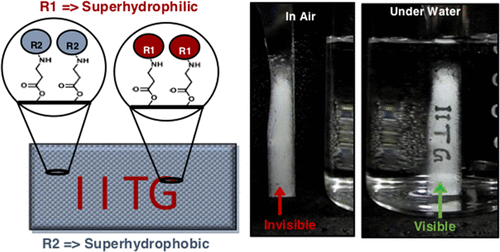
Covalently Modulated and Transiently Visible Writing: Rational Association of Two Extremes of Water Wettabilities
-
Author:
S. Das, R. Kumar, D. Parbat, S. Sekula-Neuner, M. Hirtz, U. Manna
-
Source:
ACS Appl. Mater. Interfaces 12 (2020) 2935-2943
- Date: 2020
-
Anticounterfeiting measures are of ever-increasing importance in society, e.g., for securing the authenticity of and the proof of origin for medical drugs. Here, an arms race of counterfeiters and valid manufacturers is taking place, resulting in the need of hard-to-forget, yet easy-to-read out marks. Anticounterfeiting measures based on micropatterns—while being attractive for their need in not widely available printing methods while still being easily read out with fairly common basic optical equipment—are often limited by being too easy to be destroyed by wear or handling. Here, nature-inspired wettability is rationally exploited for developing an unprecedented anticounterfeiting method, where hidden information can be only identified under direct exposures to an aqueous phase or mist and disappears again on air-drying the interface. A chemically reactive and hierarchically featured dip coating, capable of spatially selective covalent modification with primary amine containing small molecules, is developed for abrasion-tolerant patterning interfaces with two extremes of water wettabilities, i.e., superhydrophilicity and superhydrophobicity. Arbitrary handwriting with glucamine followed by chemical modification with octadecylamine, provided “invisible” text on the synthesized interface. The glucamine-treated region selectively becomes optically transparent and superhydrophilic due to rapid infiltration of the aqueous phase on exposure to liquid water or mist. The remaining interface remains opaque and superhydrophobic due to metastable entrapment of air. The hidden text became transiently and reversibly visible by the naked eye under exposure to liquid water/mist. Furthermore, microchannel-cantilever spotting (μCS) is adopted for demonstrating well-defined chemical patterning on the microscale. These patterns are at the same time highly resistant against wear and scratching because of the bulk functionalization, retaining the wetting properties (and thus pattern readout) even on serious abrasion. Such a simple synthesis of spatially controlled, direct, and covalently modulated wettability could be useful for various applied and fundamental contexts.
